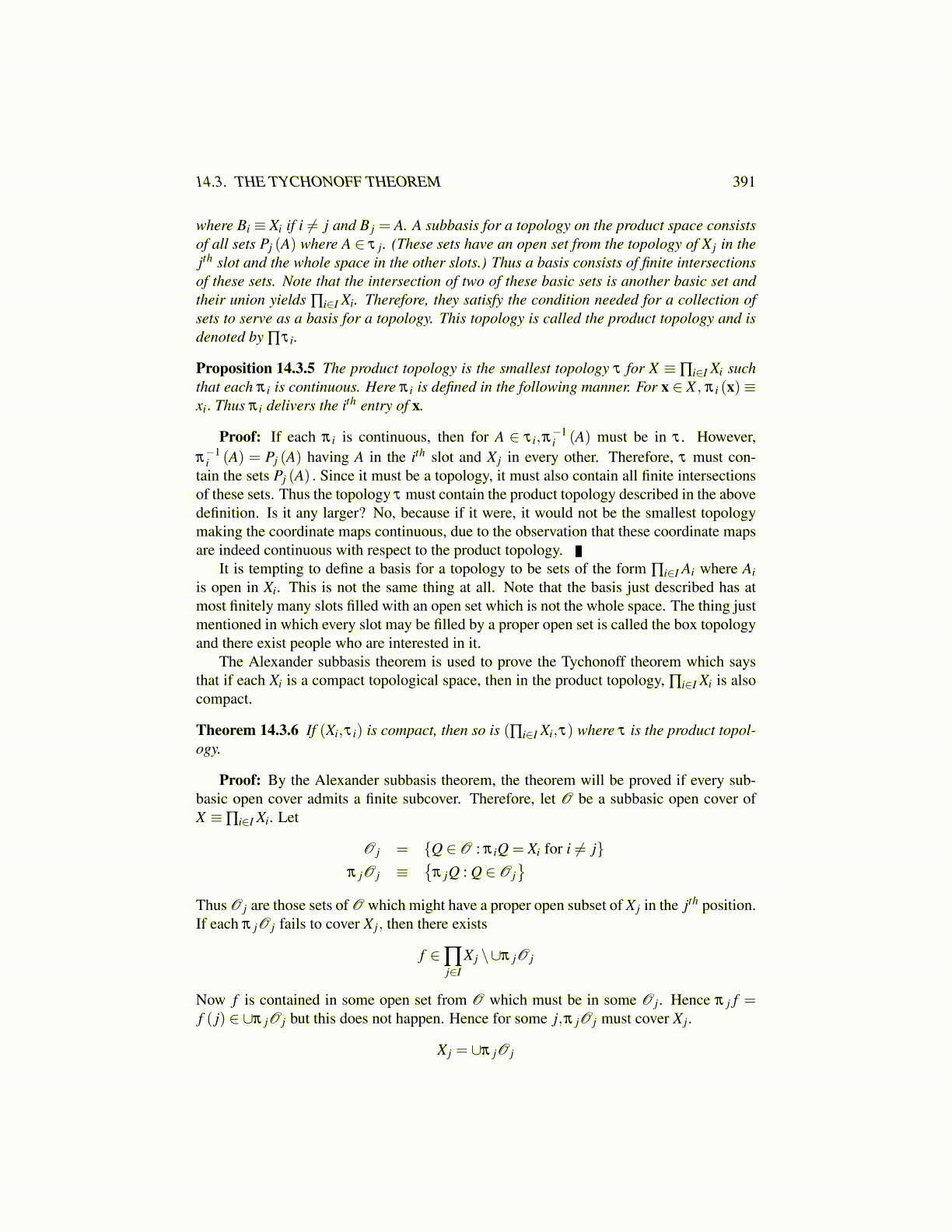
14.3. THE TYCHONOFF THEOREM 391
where Bi ≡ Xi if i ̸= j and B j = A. A subbasis for a topology on the product space consistsof all sets Pj (A) where A ∈ τ j. (These sets have an open set from the topology of X j in thejth slot and the whole space in the other slots.) Thus a basis consists of finite intersectionsof these sets. Note that the intersection of two of these basic sets is another basic set andtheir union yields ∏i∈I Xi. Therefore, they satisfy the condition needed for a collection ofsets to serve as a basis for a topology. This topology is called the product topology and isdenoted by ∏τ i.
Proposition 14.3.5 The product topology is the smallest topology τ for X ≡∏i∈I Xi suchthat each π i is continuous. Here π i is defined in the following manner. For x ∈ X , π i (x)≡xi. Thus π i delivers the ith entry of x.
Proof: If each π i is continuous, then for A ∈ τ i,π−1i (A) must be in τ . However,
π−1i (A) = Pj (A) having A in the ith slot and X j in every other. Therefore, τ must con-
tain the sets Pj (A) . Since it must be a topology, it must also contain all finite intersectionsof these sets. Thus the topology τ must contain the product topology described in the abovedefinition. Is it any larger? No, because if it were, it would not be the smallest topologymaking the coordinate maps continuous, due to the observation that these coordinate mapsare indeed continuous with respect to the product topology.
It is tempting to define a basis for a topology to be sets of the form ∏i∈I Ai where Aiis open in Xi. This is not the same thing at all. Note that the basis just described has atmost finitely many slots filled with an open set which is not the whole space. The thing justmentioned in which every slot may be filled by a proper open set is called the box topologyand there exist people who are interested in it.
The Alexander subbasis theorem is used to prove the Tychonoff theorem which saysthat if each Xi is a compact topological space, then in the product topology, ∏i∈I Xi is alsocompact.
Theorem 14.3.6 If (Xi,τ i) is compact, then so is (∏i∈I Xi,τ) where τ is the product topol-ogy.
Proof: By the Alexander subbasis theorem, the theorem will be proved if every sub-basic open cover admits a finite subcover. Therefore, let O be a subbasic open cover ofX ≡∏i∈I Xi. Let
O j = {Q ∈ O : π iQ = Xi for i ̸= j}π jO j ≡
{π jQ : Q ∈ O j
}Thus O j are those sets of O which might have a proper open subset of X j in the jth position.If each π jO j fails to cover X j, then there exists
f ∈∏j∈I
X j \∪π jO j
Now f is contained in some open set from O which must be in some O j. Hence π j f =f ( j) ∈ ∪π jO j but this does not happen. Hence for some j,π jO j must cover X j.
X j = ∪π jO j